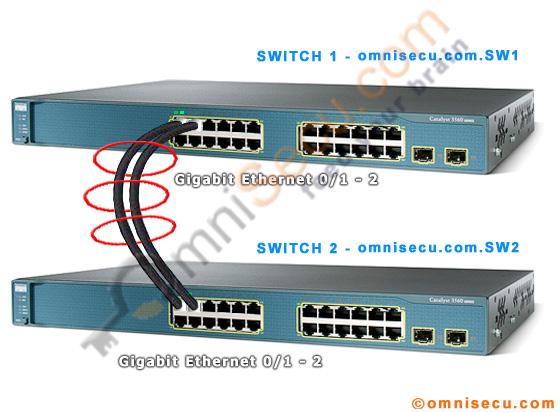What is Etherchannel in Cisco Switches and Routers, What is Link Aggregation and what are PAgP LACP
EtherChannel is a port link aggregation technology developed by Cisco, which provides fault-tolerant high-speed links between Switches, Routers, and Servers. EtherChannel technology allows multiple physical Ethernet links (Fast Ethernet or Gigabit Ethernet) to combine into one logical channel.
EtherChannel technology allows grouping of several physical Ethernet links (Fast Ethernet, Gigabit Ethernet, or 10 Gigabit Ethernet) to create one logical Ethernet link for the purpose of providing fault-tolerance and high-speed links between switches, routers and servers.
EtherChannel technology can be used to increase the bandwidth between two devices that support EtherChannel technology and EtherChannel technology provides automatic recovery for the loss of a link by redistributing the load across the remaining links. EtherChannel technology allows automatic redirection of network traffic from the failed link to the remaining links in EtherChannel.
An EtherChannel consists of individual Fast Ethernet or Gigabit Ethernet or 10-Gigabit links bundled into a single logical link. The EtherChannel provides full-duplex bandwidth up to 800 Mbps (Fast EtherChannel FEC) or 8 Gbps (Gigabit EtherChannel) or 10 Gbps (10-Gigabit Etherchannel 10 GEC) between Switches, Routers and Servers.
The main advantages of EtherChannel technology is that it allows load sharing of traffic among the links in the channel as well as redundancy in the event that one or more links in the EtherChannel fail.
EtherChannel is a Cisco Copyrighted term and the term which industry adopted is "Link Aggregation".

There are two protocols used for negotiating EtherChannel and Link Aggregation. We can configure Etherchannel in three ways in Cisco Switches.
- Port Aggregation Protocol (PAgP) - Cisco Proprietary protocol
- IEEE Link Aggregation Protocol (LACP) - Industry Standard
- Manual Etherchannel Configuration - Without using any negotiation protocol listed above
The Port Aggregation Protocol (PAgP) and Link Aggregation Control Protocol (LACP) can be used for EtherChannel negotiation. Port Aggregation Protocol (PAgP) is a Cisco proprietary protocol. Therefore PAgP can be used to negotiate EtherChannels only between Cisco switches.
Link Aggregation Control Protocol (LACP) is an industry standard defined in IEEE 802.3AD. Using Link Aggregation Control Protocol (LACP), Cisco switches can negotiate Link Aggregation with switches from different vendors that support 802.3AD protocol.
Port Aggregation Protocol (PAgP) or Link Aggregation Control Protocol (LACP) is used by a Switch to learn the identity of partners, capability of partners and the interface properties and capabilities. Port Aggregation Protocol (PAgP) or Link Aggregation Control Protocol (LACP) groups similarly configured interfaces into a single logical link present the group to Spanning Tree Protocol (STP) as a single switch port.
Click the following links to know about Port Aggregation Protocol (PAgP) Link Aggregation Control Protocol (LACP) Channel modes.